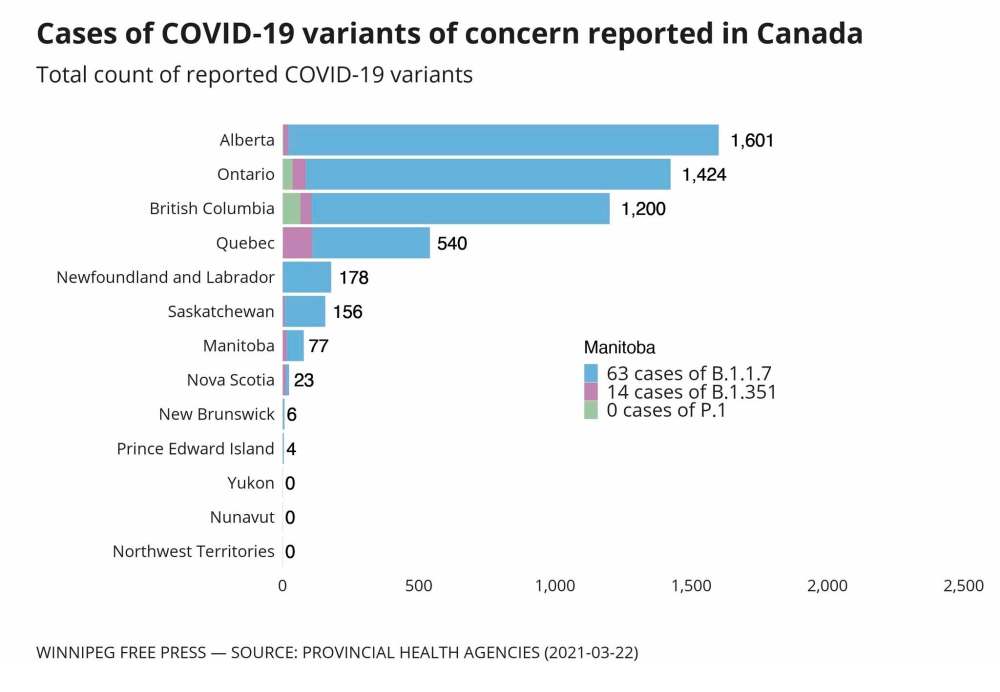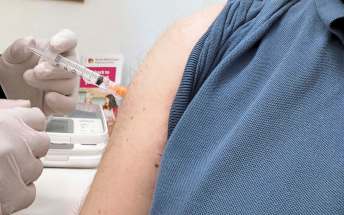Manitoba on collision course with third wave, experts warn Further loosening restrictions will allow COVID variant case numbers to spiral out of control, say Ontario, Saskatchewan scientists
Read this article for free:
or
Already have an account? Log in here »
To continue reading, please subscribe:
Monthly Digital Subscription
$0 for the first 4 weeks*
- Enjoy unlimited reading on winnipegfreepress.com
- Read the E-Edition, our digital replica newspaper
- Access News Break, our award-winning app
- Play interactive puzzles
*No charge for 4 weeks then price increases to the regular rate of $19.00 plus GST every four weeks. Offer available to new and qualified returning subscribers only. Cancel any time.
Monthly Digital Subscription
$4.75/week*
- Enjoy unlimited reading on winnipegfreepress.com
- Read the E-Edition, our digital replica newspaper
- Access News Break, our award-winning app
- Play interactive puzzles
*Billed as $19 plus GST every four weeks. Cancel any time.
To continue reading, please subscribe:
Add Free Press access to your Brandon Sun subscription for only an additional
$1 for the first 4 weeks*
*Your next subscription payment will increase by $1.00 and you will be charged $16.99 plus GST for four weeks. After four weeks, your payment will increase to $23.99 plus GST every four weeks.
Read unlimited articles for free today:
or
Already have an account? Log in here »
Hey there, time traveller!
This article was published 22/03/2021 (1725 days ago), so information in it may no longer be current.
OTTAWA — Looking back six weeks ago, Dr. Dick Zoutman wishes Ontario had resisted the urge to peel back COVID-19 restrictions, in a situation somewhat analogous to Manitoba’s current situation.
In early February, his province’s case counts were dropping amid a trickle of cases involving highly contagious variant strains.
Zoutman, a professor of infectious diseases and medical microbiology at Queen’s University in Kingston, Ont., recalls a sense of dread as officials announced restaurants would be permitted to open for indoor dining and loosened rules on household gatherings.

“You have a virus that spreads faster, that’s increasing and has the potential to make people sicker, so I’m very worried about it,” recalled Zoutman, who has argued for strict measures used by countries such as Australia, until COVID-19 nearly disappears.
Instead, provinces are loosening rules; Manitoba will announce rolled-back restrictions as soon as Tuesday.
“This virus is smart and it’s fast, and we need to be smarter and we need to be faster,” Zoutman said.
“This third wave is going to be very damaging to the economy and to people’s health, and causing mortality that is totally preventable.”
– Dr. Dick Zoutman
As Ontario allowed people to have more visitors and larger events, the drop in case numbers stalled. The rolling average of cases plateaued for about three weeks before sharply rising.
Data from the Ontario government’s own science advisory table suggests caseloads would have flattened by now if the highly contagious variants hadn’t emerged.
Cities such as Ottawa reopened gyms and shopping malls at capacity levels that were supposed to remain through the spring. Instead, they had to reinstate restrictions just a month later.
British variant appears more deadly
OTTAWA — While viruses tend to mutate to be less deadly, the COVID-19 variant that took hold in Britain seems to be taking the opposite approach.
“It’s a cause for grave concern,” said Dr. Dick Zoutman, a professor of infectious diseases and medical microbiology at Queen’s University.
The main variants of concern all have a mutation that seems to allow the spike protein to more easily cling onto cells and infect them.
OTTAWA — While viruses tend to mutate to be less deadly, the COVID-19 variant that took hold in Britain seems to be taking the opposite approach.
“It’s a cause for grave concern,” said Dr. Dick Zoutman, a professor of infectious diseases and medical microbiology at Queen’s University.
The main variants of concern all have a mutation that seems to allow the spike protein to more easily cling onto cells and infect them.
The B.1.1.7 variant took hold in the United Kingdom, where officials said in January that it appeared more deadly.
That presumption seems to be clearer each month, with a University of Exeter study published March 10 finding that people infected with the variant seemed about 64 per cent more likely to die than patients infected with other strains.
It’s the variant taking hold in most provinces.
Zoutman said viruses tend to become less deadly as they mutate, which evolutionary biologists chalk up to a drive to infect more people and replicate, which doesn’t work when the host dies.
“It may seem counterintuitive,” Zoutman said of the British variant.
“It’s not killing all the hosts, it’s killing more — but it’s more infectious and there are plenty of people in Canada who are not immune,” he said, noting infection and vaccination rates.
“They are interacting with other people in a way that increases opportunity for spread. From the virus’s point of view, that’s exactly what it needs — and it will capitalize on that.”
— Dylan Robertson
“This third wave is going to be very damaging to the economy and to people’s health, and causing mortality that is totally preventable,” Zoutman said.
“The variants of concern out-compete the original strain of COVID-19.”
A similar situation appears to be playing out in Saskatchewan, where there were just 35 variant cases documented on March 9. That number doubled within four days and, a week later, rose to 664, largely concentrated in Regina.
That staggering rise has nothing to do with anomalies in how officials track cases or do testing, said University of Saskatchewan epidemiology professor Dr. Nazeem Muhajarine.
“We’re seeing, right before our eyes, in the space of two weeks, an exponential growth of variant cases in Regina,” said Muhajarine.
He said it probably didn’t help that the province relaxed capacity limits on religious services to allow up to 150 people to attend, and loosened the limit on household gatherings, from five people to 10 from three different households.
Muhajarine noted that Manitoba has had stricter rules than Saskatchewan, and hailed the colour-code system here, which helps differentiate risk by region.
But he warned that Winnipeg’s situation might start looking a lot like Regina’s. There were 29 active variant cases in Manitoba as of Friday, not far from the starting point of the 35 cases in Saskatchewan that quickly got out of control.
“We’re seeing, right before our eyes, in the space of two weeks, an exponential growth of variant cases in Regina.”
– Dr. Nazeem Muhajarine
The B.1.1.7 variant that took hold in Britain is largely driving these cases across Western Canada, and research points to it being more contagious and, likely, more deadly.
Other variants are wreaking havoc elsewhere.
Quebec’s mining region of Abitibi has become a North American stronghold for the B.1.351 variant, first identified in South Africa. The rural area went from reporting two cases of the variant to 100 in just five weeks.
To date, no other province has logged more than 47 cases of that variant, while the entire United States has reported fewer than 200 cases.
While the South African strain is not known to be deadlier, it is more contagious than previous iterations of the coronavirus, and appears somewhat more resistant to at least some of the available vaccines.
Manitoba’s chief public health officer said Monday that he’s trying to balance the impact of restrictions with the need to keep case numbers down.
“We all want to use the least-restrictive means to obtain our goal, because these restrictions themselves have health impacts,” Dr. Brent Roussin said.
“As you loosen restrictions, you’re going to see more and more interaction. And just like we see now, you’ll see an increasing in cases — adding to that, we now have these variants of concern which are 50 to 70 per cent more infectious.”
“We all want to use the least-restrictive means to obtain our goal, because these restrictions themselves have health impacts.”
– Dr. Brent Roussin
Muhajarine said that’s exactly why Manitoba needs to shift its balance.
“Public-health measures do have collateral consequences, like mental health and isolation, and a lack of support — but the thing is that we want to prevent the most negative of outcomes that we could imagine, including death and hospitalizations and ICU bed use,” he said.
Manitobans should stick with the restrictions they already have for another four to six weeks, by which point a ramp-up in vaccines will start protecting the most vulnerable, at which point limitations could be gradually scaled down, he said.
Otherwise, Manitoba will join the list of jurisdictions where a nasty third wave has pushed things back into code red in order to prevent overloaded hospitals from having to turn back patients who are most likely to die, he predicted.
“To me, that would demand whatever we can do now to avoid those kinds of really negative outcomes,” he said.
dylan.robertson@freepress.mb.ca









